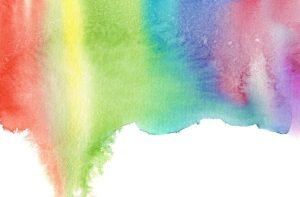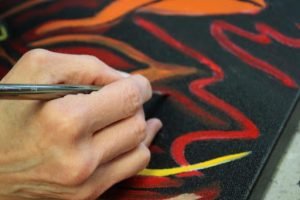Abstract Art Ideas: 15 best Techniques and Tips for Every Medium
Having decorating ideas and a plan for your abstract art piece before you begin is essential to its completion. Starting with a plan and then executing your idea allows you to organize the composition in the best way, communicate effectively with your medium and accomplish your goals. To help you understand abstract art, this article provides tips for creating all kinds of abstract Wall Paintings. Here we share 15 fresh abstract art ideas ideas that promise to broaden design of your interior.
What Is Abstract Art?

Abstract art is a style in which artists do not attempt to represent objects in nature. Instead, abstract artists seek to express something beyond the literal appearance of objects surrounding us in everyday life.
The term abstract art came into use after World War II, replacing “non-figurative art.” At this time, abstraction indicated a departure from depicting natural objects into work that involved geometric form, depicting subjects with fewer and simpler elements. Abstract art was influenced by Modern art paintings like cubism, futurism, surrealism, and constructivism. By the mid-20th century, artists such as Pollock and de Kooning turned to more expressionist abstract styles that involved free-form and gestural techniques.
Elements Make Up Abstract Art
Abstract art is an artist’s interpretation of natural or real-world subjects without specific regard to the subject. As a result, an abstract artist’s vocabulary will vary depending on the materials used, the process, and the elements that make up their style.
Abstract art ideas can feature the following elements:
- Color: Whether used monochromatically or in combination, color conveys shape and space and creates moods that help support the artist’s intent.
- Form: Abstract forms can be geometric (circle, square, triangle) or organic (flowers, mountains). They can be structured, painted, or made up of found materials.
- Texture: Abstract artists may use texture to create form and depth through the repetition of a pattern or materials that create a physical response.
- Space: Although abstract artists do not depict reality, they can convey space through color, texture, and form.
- Time: Abstract Contemporary Paintings can convey movement through lines or repetition of shapes, which can lead the eye across the surface of the work.
- Light and Shadow: Abstract artists can use light and shadow to create patterns that convey space, contrast, or mood.
- Balance: In abstract art, balance does not necessarily mean symmetry. It can be created through color, line, form, and many small objects or a few more significant elements.
- Value: Value creates mood and provides a form in abstract Wall art paintings, whether through light and dark or the contrast of black and white.
- Depth: In abstract art, depth can be created through layers or by zooming in or out on an image or object.
- Surface: If abstract artists use paint, the surface will likely play a significant role in their work.
What Are the Abstract Art Ideas, Techniques, and Tips?

Abstract art is a style in which the artist does not attempt to represent objects in nature. Instead, abstract artists seek to express something beyond the literal appearance of the objects that surround us in everyday life. Let’s look at the best tips and tricks about abstract art that fill your aim.
- Breaking the Rules of Perspective
Just because you can’t see them through the camera lens doesn’t mean they aren’t there. That perspective is critical because it allows for the illusion of 3D space within your art. If you choose to break this illusion, you will be left with abstract work. If you decide to stick with it, your work will be abstracted rather than simply appearing as a photo.
- Repetition is the Key
While searching for abstract art ideas, don’t ignore repetition. Repetition is a critical element of abstract art. Choose one idea and work on it until you find a single way to represent it. This could be through color, shape, texture, or another element. You must avoid a total lack of repetition because it will result in a confusing piece that lacks a theme.
- Combine 2D and 3D Elements
Integrating two-dimensional objects or materials with your abstract work will make it more engaging.
- Experiment With Color
Cool or warm colors can create their mood, so experiment with color to discover the best way to enhance your abstract art.
- Remember the Basics
Proportion, balance, and color are all significant, whether you are creating abstract art or not. There is no need to avoid them altogether, but it is important not to rely on them.
- The More the Merrier
Abstract art doesn’t have to be a solitary process. Work with others to create a piece of abstract art that represents your group’s ideas, or take inspiration from another artist and use their ideas to create your vision.
- Avoid the Engineered
Although some abstract art will result from a clever design, it will lack soul without the artist’s touch. If you are thinking of creating abstract art, look beyond what has gone before and find your voice.
- Draw With Confidence

Drawing is the foundation of all abstract art. Sometimes artists will sketch out an idea before creating their final piece, so learn to draw with confidence.
- Think About the Texture
Texture can add dimension to abstract art, whether through the paint (loose or highly textured) or more tangible materials. You can even create abstract art using a less traditional texture, like bubble wrap.
- Create a Flow
Abstract art is often created as one cohesive work, but it can also be created as a series of paintings or works on paper.
- Get Inspired

One of the best ways to create an abstract work is to study other artists’ abstract works. Check out our list of Abstract Art Resources for some inspiration.
- Combine Oil and Acrylic
Painting Abstract Paintings using oil and acrylic is a fun technique that creates layers and visual interest.
- Create a Cut Paper Effect
Cutting paper before pasting it onto another surface can create a lovely effect.
- Create a Mood Board
A mood board will help you visualize the type of abstract art you’d like to create. It can be made using paint swatches, fabric, paper, or anything else that inspires you.
- Create a Visual Outline
Draw lines on a piece of paper, creating an outline of the space your abstract work will occupy. This technique can help you plan your composition. We have these abstract art ideas will give your interior space an amazing feature.
READ NEXT:5 best large wall Art painting ideas to Supersize your style
RELATED TOPICS: wall paintings for decor

